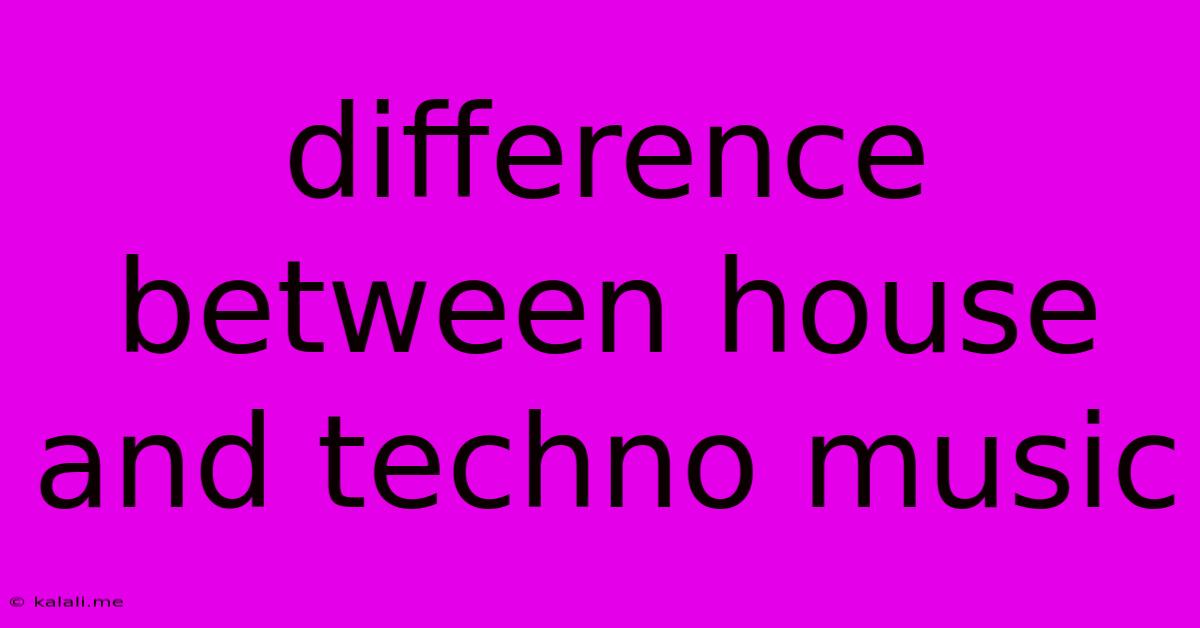Difference Between House And Techno Music
Kalali
May 22, 2025 · 3 min read

Table of Contents
House vs. Techno: Deconstructing the Beats
For many, house and techno music seem interchangeable, both residing under the broad umbrella of electronic dance music (EDM). However, seasoned listeners and DJs know there's a significant difference in their sounds, origins, and cultural impact. This article delves into the key distinctions between house and techno, exploring their tempos, instrumentation, and overall feel. Understanding these differences will elevate your appreciation for both genres and help you navigate the vast landscape of electronic music.
What defines House Music?
House music, born in Chicago during the early 1980s, is characterized by its four-on-the-floor beat, typically at a tempo ranging from 118 to 135 beats per minute (BPM). Its rhythmic foundation often includes a prominent bassline, typically a synthesized bassline, and a driving kick drum. This creates a feeling of continuous motion and groove, making it highly danceable.
Key Characteristics of House Music:
- Tempo: 118-135 BPM
- Rhythm: Strong four-on-the-floor beat, often with a prominent kick drum and bassline.
- Instrumentation: Synthesizers, drum machines, samplers, vocals (often soulful or gospel-influenced).
- Feel: Uplifting, energetic, and often euphoric. Subgenres like deep house can be more mellow and introspective.
- Notable Subgenres: Deep house, Chicago house, acid house, tech house.
What defines Techno Music?
Techno, emerging from Detroit in the mid-1980s, shares the four-on-the-floor beat with house, but generally operates at a faster tempo, typically between 120 and 150 BPM, sometimes even exceeding that. The overall feel is often darker, more hypnotic, and less overtly funky than house. While synthesizers are central, the focus tends to be on creating atmospheric soundscapes and complex rhythmic patterns rather than catchy melodies.
Key Characteristics of Techno Music:
- Tempo: 120-150 BPM (and sometimes faster)
- Rhythm: Intricate and often repetitive, emphasizing the hypnotic quality.
- Instrumentation: Synthesizers, drum machines, samplers, often with a less pronounced emphasis on vocals.
- Feel: Darker, more hypnotic, and often minimalist. Subgenres explore different moods, from ambient to aggressive.
- Notable Subgenres: Detroit techno, minimal techno, acid techno, hard techno.
The Key Differences Summarized:
| Feature | House Music | Techno Music |
|---|---|---|
| Tempo | 118-135 BPM | 120-150 BPM (often faster) |
| Feel | Uplifting, energetic, groovy | Darker, hypnotic, atmospheric |
| Instrumentation | More emphasis on vocals and catchy melodies | Less emphasis on vocals, focus on soundscapes |
| Bassline | Often prominent and melodic | Can be prominent but less melodic, more rhythmic |
| Origins | Chicago, early 1980s | Detroit, mid-1980s |
Beyond the Basics:
The lines between house and techno can blur, with subgenres like tech house bridging the gap. Many DJs and producers seamlessly blend elements from both genres, resulting in a dynamic and ever-evolving soundscape. Ultimately, understanding the core characteristics outlined above allows for a more nuanced appreciation of both house and techno music's unique contributions to electronic music. The journey of discovery through these genres is a rewarding one, filled with innovative sounds and captivating rhythms.
Latest Posts
Latest Posts
-
White Mushroom Growing In Potted Plant
May 22, 2025
-
There Are None So Blind As Those
May 22, 2025
-
Is It Sunnah To Have A Cat
May 22, 2025
-
How To Say In Spanish I Dont Speak Spanish
May 22, 2025
-
How To Get Hair Out Of Carpet
May 22, 2025
Related Post
Thank you for visiting our website which covers about Difference Between House And Techno Music . We hope the information provided has been useful to you. Feel free to contact us if you have any questions or need further assistance. See you next time and don't miss to bookmark.